 |
||
|
||
| ||
This article is devoted to a very useful thing - a miniature camera, named Canon Digital IXUS. First comes the specification: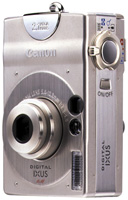
As far as ergonomics is concerned I should say that the camera fits the right hand perfectly, do not be afraid to cover the lens or the flash. You can get the camera, switch it on and take a shoot with one hand, but for deletion of a shot and for changing settings you have to use both hands. For interface cables there is used a single multifunctional connector. We, however, failed to learn whether it can be used for external flash control or for camera control with an external remote controller. Now let's check its performance in the tasks it's intended for. As a digital cameraThe image size - 1600X1200 pixels - is enough in the vast majority of cases, and for other cases there is a possibility to stick together several frames in one (PhotoStitch program in provided). Remember that according to the experiments the number of lines higher than 1100-1200 does not yield further improvement in perception of images by a human. The dynamic range of brightness is not the best one, only 8 bit per channel. But in the majority of pictures the bright colors and deep shades correspond to slow-moving frame's elements, and if you are not lazy you can make two shots with exposure correction +2 and -2, and to get the virtual 12 bit per channel, and then, working on transmission bands when matching these shots in PhotoShop, receive a high-detailed image both in shades and in the light. (Unfortunately, PhotoStitch refused to work with images differing 16 times in brightness). That's why you'd better not spend the precious memory for odd resolution and dynamic range (which are anyway absent in this camera), and just make additional shots when necessary. A small size of the lens allows to rest it against an eye-piece of binoculars, but bothering about two tripods immediately or stitching of a connecting housing binocular/camera/tripod is a business not for lazy people (Canon offers binoculars with optical image stabilization but its price is equal to that of this camera). You should know that for rational use of the Li-ion battery, the discharge rate mustn't exceed its rated value in ampere-hours. That's why it's better to use an optical viewfinder (holding the release button pressed an image will appear on the screen even if it is off). The size of the visual area of the optical viewfinder is around 80% of the shot. The camera suits a shirt pocket, but it weighs it down. That's why you'd better carry it on the belt. Small dimensions of the camera and the battery that can be recharged any time without fearing a memory effect give that pleasant opportunity to take it always with you and shoot all the time... As an illustration of its advantages here are two shots of the same place. The first one is made with the IXUS. The second was displayed at the "Silvery camera-2000" and seemed to be shot half an hour later.

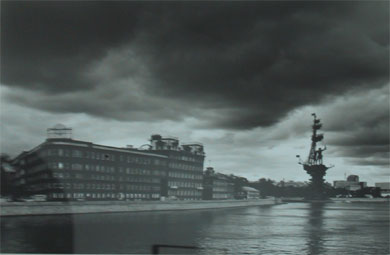 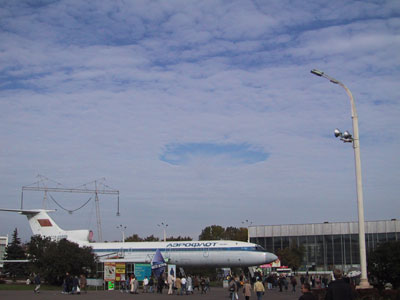 Slide-scanner
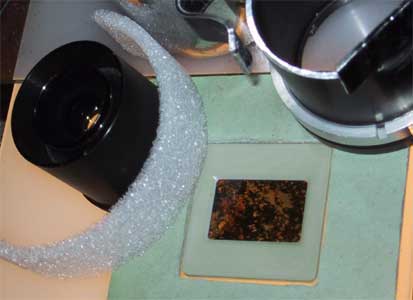
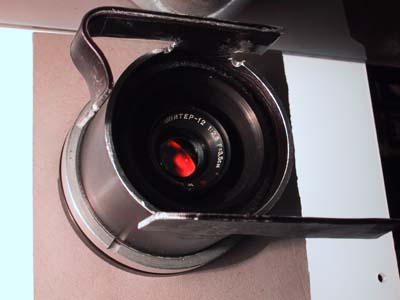 With the help of the camera, magnifying optical devices and a lighting table it's possible to reshoot films or slides. In the construction shown we used something like a lighting table made of opal glass and opal tungsten lamp, a layer of the slide's width, the lens Upiter-12 fixed with a resilient gasket in a metal cylinder the upper part of which is intended for camera fixation. Now we position a slide in the cut-off of the layer, put above a cylinder with the camera, place a balance for the tungsten lamp, switch Macro mode and make a series of 6 shots moving the cylinder along the layer. For the brightness of the shots to be the same I recommend to switch on the lamp via a stabilizer, or at least to choose reshooting time not at the energy rush-hour, and of course, do not touch the lamp while shooting the series. After a bit of working on it in PhotoStitch, and we receive 3300X2200 image. Unfortunately, in the most images a 8-MBytes card of the complete set in Superfine mode can house only 5 shots, but with the Fine mode grains of the ORWO film are rather noticeable.

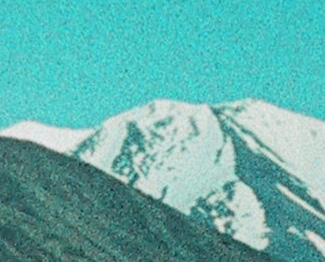 As you know, Compact-flash emulates a hard disc, and hard discs can contain bad sectors. To all appearances, the flash-memory is not that good either – with a blank 8 MBytes card from the complete set the camera reports about 28 KBytes used, and with a blank no-name 32 MBytes card it states that 4 KBytes are used. Scanner for textsThe latest Finereader perfectly recognizes shot A5 sheets (book pages including comments made by a small print) illuminated with two tungsten lamps from the opposite corners. For bigger formats it gets more difficult to provide the required brightness and uniform illumination. Note bookA human's eye, unlike Finereader, is less exacting to the uniform brightness of an image, and it's possible to read a newspaper sheet which is shot wholly, though for viewing on the screen of the camera even with 3x enlargement you need a greater scale. It's very convenient - you can make a photo of advertisement, changes in timetable, prices and appearance of goods - everything will be with you. Video cameraThe image of the camera screen doubles on the video output (PAL coding) and can be recorded on a VCR. Mobilty of this device, though, is not huge. TorchIn the anti red eye mode the lamp (or rather LED) of the autofocus system lights continuously while the release button is half-pressed. It's rather convenient to use this feature instead of a torch. ShockerThe Description says that you mustn't direct the light into eyes if the distance is short. But this can be used for defense... SummaryThere are cameras smaller in size, there are cameras with a better image
quality. The Canon Digital IXUS is close to the golden mean. The main downside
is a low sensitivity (100 ISO), what is explained by a small size of a
CCD-matrix. But note that a big matrix requires a big lens, that's why
a tiny camera with high sensitivity will appear in the far future.
Write a comment below. No registration needed!
|
Platform · Video · Multimedia · Mobile · Other || About us & Privacy policy · Twitter · Facebook Copyright © Byrds Research & Publishing, Ltd., 1997–2011. All rights reserved. |